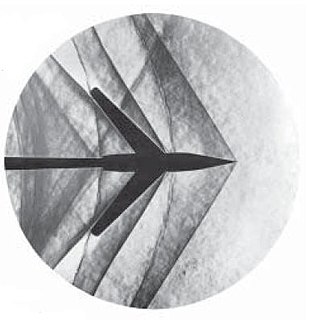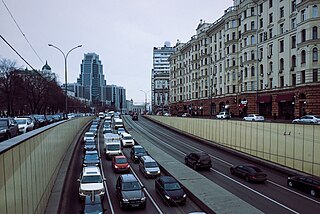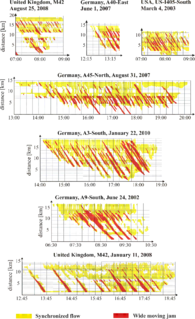
Traffic comprises pedestrians, vehicles, ridden or herded animals, trains, and other conveyances that use public ways (roads) for travel and transportation.

In physics, a shock wave, or shock, is a type of propagating disturbance that moves faster than the local speed of sound in the medium. Like an ordinary wave, a shock wave carries energy and can propagate through a medium but is characterized by an abrupt, nearly discontinuous, change in pressure, temperature, and density of the medium.
Compressible flow is the branch of fluid mechanics that deals with flows having significant changes in fluid density. While all flows are compressible, flows are usually treated as being incompressible when the Mach number is smaller than 0.3. The study of compressible flow is relevant to high-speed aircraft, jet engines, rocket motors, high-speed entry into a planetary atmosphere, gas pipelines, commercial applications such as abrasive blasting, and many other fields.

In fluid dynamics, a wake may either be:

Traffic congestion is a condition in transport that is characterized by slower speeds, longer trip times, and increased vehicular queueing. Traffic congestion on urban road networks has increased substantially since the 1950s. When traffic demand is great enough that the interaction between vehicles slows the speed of the traffic stream, this results in some congestion. While congestion is a possibility for any mode of transportation, this article will focus on automobile congestion on public roads.

Sir Michael James Lighthill was a British applied mathematician, known for his pioneering work in the field of aeroacoustics and for writing the Lighthill report on artificial intelligence.
In mathematics and transportation engineering, traffic flow is the study of interactions between travellers and infrastructure, with the aim of understanding and developing an optimal transport network with efficient movement of traffic and minimal traffic congestion problems.
Computational aeroacoustics is a branch of aeroacoustics that aims to analyze the generation of noise by turbulent flows through numerical methods.
Gas kinetics is a science in the branch of fluid dynamics, concerned with the study of motion of gases and its effects on physical systems. Based on the principles of fluid mechanics and thermodynamics, gas dynamics arises from the studies of gas flows in transonic and supersonic flights. To distinguish itself from other sciences in fluid dynamics, the studies in gas dynamics are often defined with gases flowing around or within physical objects at speeds comparable to or exceed the speed of sound and causing a significant change in temperature and pressure. Some examples of these studies include but are not limited to: choked flows in nozzles and valves, shock waves around jets, aerodynamic heating on atmospheric reentry vehicles and flows of gas fuel within a jet engine. At the molecular level, gas dynamics is a study of the kinetic theory of gases, often leading to the study of gas diffusion, statistical mechanics, chemical thermodynamics and non-equilibrium thermodynamics. Gas dynamics is synonymous with aerodynamics when the gas field is air and the subject of study is flight. It is highly relevant in the design of aircraft and spacecraft and their respective propulsion systems.
The Downs–Thomson paradox, also known as the Pigou–Knight–Downs paradox, states that the equilibrium speed of car traffic on a road network is determined by the average door-to-door speed of equivalent journeys taken by public transport.

Three-phase traffic theory is a theory of traffic flow developed by Boris Kerner between 1996 and 2002. It focuses mainly on the explanation of the physics of traffic breakdown and resulting congested traffic on highways. Kerner describes three phases of traffic, while the classical theories based on the fundamental diagram of traffic flow have two phases: free flow and congested traffic. Kerner’s theory divides congested traffic into two distinct phases, synchronized flow and wide moving jam, bringing the total number of phases to three:

Boris S. Kerner is a German physicist and civil engineer who created three phase traffic theory. The three phase traffic theory is the framework for the description of empirical vehicular traffic states in three traffic phases: (i) free traffic flow (F), (ii) synchronized traffic flow (S), and (iii) wide moving jam (J). The synchronized traffic flow and wide moving jam phases belong to congested traffic.
Gerald Beresford Whitham FRS was a British–born American applied mathematician and the Charles Lee Powell Professor of Applied Mathematics (Emeritus) of Applied & Computational Mathematics at the California Institute of Technology. He received his Ph.D. from the University of Manchester in 1953 under the direction of Sir James Lighthill. He is known for his work in fluid dynamics and waves.

Traffic simulation or the simulation of transportation systems is the mathematical modeling of transportation systems through the application of computer software to better help plan, design, and operate transportation systems. Simulation of transportation systems started over forty years ago, and is an important area of discipline in traffic engineering and transportation planning today. Various national and local transportation agencies, academic institutions and consulting firms use simulation to aid in their management of transportation networks.
A Macroscopic traffic flow model is a mathematical traffic model that formulates the relationships among traffic flow characteristics like density, flow, mean speed of a traffic stream, etc.. Such models are conventionally arrived at by integrating microscopic traffic flow models and converting the single-entity level characteristics to comparable system level characteristics. An example is the Two-fluid model.
Cell Transmission Model (CTM) is a popular numerical method proposed by Carlos Daganzo to solve the kinematic wave equation. Lebacque later showed that CTM is the first order discrete Godunov approximation.

Vehicular traffic can be either free or congested. Traffic occurs in time and space, i.e., it is a spatiotemporal process. However, usually traffic can be measured only at some road locations. For efficient traffic control and other intelligent transportation systems, the reconstruction of traffic congestion is necessary at all other road locations at which traffic measurements are not available. Traffic congestion can be reconstructed in space and time based on Boris Kerner’s three-phase traffic theory with the use of the ASDA and FOTO models introduced by Kerner. Kerner's three-phase traffic theory and, respectively, the ASDA/FOTO models are based on some common spatiotemporal features of traffic congestion observed in measured traffic data.
In gravity and pressure driven fluid dynamical and geophysical mass flows such as ocean waves, avalanches, debris flows, mud flows, flash floods, etc., kinematic waves are important mathematical tools to understand the basic features of the associated wave phenomena. These waves are also applied to model the motion of highway traffic flows.
Urban traffic modeling and analysis is part of the advanced traffic intelligent management technologies that has become a crucial sector of Traffic management and control. Its main purpose is to predict congestion states of a specific urban transport network and propose improvements in the traffic network. Researches rely on three different informations. Historical and recent information of a traffic network about its density and flow, a model of the transport network infrastructure and algorithms referring to both spatial and temporal dimensions. The final objective is to provide a better optimization of the traffic infrastructure such as traffic lights. Those optimizations should result into a decrease of the travel times, pollution and fuel consumption.
Paul Irving Richards (1923–1978) was a physicist and applied mathematician. Richard's is best known to electrical engineers for the eponymous Richards' transformation. However, much of his career was concerned with radiation transport and fluid flow. Notably, he produced one of the earliest models of traffic waves on busy highways.








